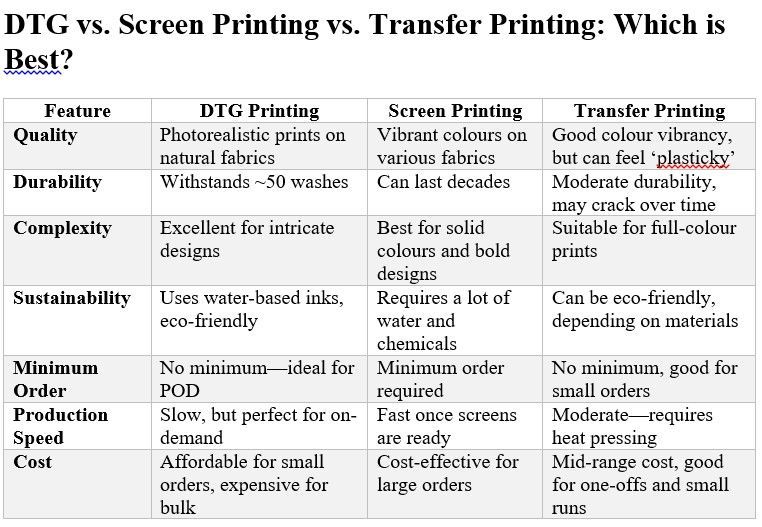Eco T shirts – Different printing techniques
David Platt • 18 March 2025
Comparing Screen Printing, Direct-to-Garment (DTG), and Transfer Printing:

Having chosen an eco-friendly T shirt (or hoodie) – the next decision is decoration. Whilst we touched on this in a previous blog (https://www.pavilionearth.co.uk/which-decoration-method-for-promotional-products-is-best-for-the-environment) it is clear that a couple of the printing methods need a degree more explanation. This is because as well as eco credentials you to consider the design and, of course, costs.
So, this article explores the pros, cons, quality, cost, and durability of three major printing techniques: DTG, screen printing, and transfer printing.
Key Takeaways
• Choose DTG for small orders and intricate designs, perfect for photorealistic custom prints.
• Choose screen printing for bulk orders, as it excels in cost-effectiveness and durability.
• Choose transfer printing for versatility, allowing full-color designs on a wide range of materials with minimal setup.
• Quality and durability vary: screen printing is the most durable, DTG is great for detailed images, and transfer printing balances ease and longevity.
• Environmental impact: DTG is the most sustainable, while transfer printing can be eco-friendly with the right materials.
• Cost considerations: Screen printing is best for large orders, DTG is cost-effective for small runs, and transfer printing offers a middle-ground solution.
________________________________________
What is Screen Printing?
Screen printing is a popular method that uses a mesh stencil to transfer ink onto fabric, creating vibrant and durable designs. Also known as silk screening, it requires creating a stencil for each color and pushing ink through the screen onto the garment.
Pros:
✔ Produces vibrant colours on light and dark fabrics.
✔ Extremely durable, lasting through many washes.
✔ Cost-effective for bulk orders.
✔ Suitable for high-intensity garments like sports uniforms.
Cons:
✖ Setup is labour-intensive and expensive for small orders.
✖ Each colour requires a new screen, increasing production time.
✖ Uses a lot of water and chemicals, making it less eco-friendly.
________________________________________
What is Direct-to-Garment (DTG) Printing?
DTG printing uses a specialized inkjet printer to spray ink directly onto fabric, allowing it to soak in. This method works best on natural fibres like cotton and is ideal for complex, multicolour designs.
Pros:
✔ Great for detailed and photorealistic images.
✔ No minimum order quantity—ideal for POD and small runs.
✔ Uses water-based inks, making it more eco-friendly.
✔ No screen setup, making it fast for single-item orders.
Cons:
✖ Less durable than screen printing; withstands about 50 washes.
✖ Works best on light-coloured, natural fabrics.
✖ Slower production time compared to screen printing.
________________________________________
What is Transfer Printing?
Transfer printing involves printing a design onto a special transfer paper or vinyl and then heat-pressing it onto the fabric. This method allows full-colour designs on various materials, including polyester and blends.
Pros:
✔ Works on a wide range of fabrics, including synthetic materials.
✔ No need for screens, making setup easy and cost-effective.
✔ Can print complex, full-color designs with minimal effort.
✔ Suitable for small batches and on-demand printing.
Cons:
✖ Not as durable as screen printing; designs may crack or fade over time.
✖ Can have a ‘plasticky’ feel, depending on the transfer material used.
✖ Some types of transfer printing require additional processing steps.
________________________________________
Quality Considerations
Print quality is crucial for customer satisfaction.
• Screen printing produces the most vibrant and durable prints, ideal for bulk apparel.
• DTG printing excels in detail and colour precision but works best on natural fabrics.
• Transfer printing allows full-colour designs on various fabrics but can have a different texture.
________________________________________
Durability
• Screen printing is the most durable, often lasting as long as the garment itself.
• DTG prints last for around 50 washes with proper care.
• Transfer prints vary in longevity, with high-quality transfers lasting for years, but cheaper versions may fade or crack sooner.
________________________________________
Environmental Impact
Sustainability is increasingly important in the apparel industry.
• DTG printing is the most eco-friendly, using water-based inks and reducing waste by printing on demand.
• Screen printing often involves plastic-based inks and significant water usage.
• Transfer printing can be sustainable if using eco-friendly transfer materials.
________________________________________
Production Time
• Screen printing takes longer to set up but is the fastest for bulk orders.
• DTG printing is slower but perfect for small orders.
• Transfer printing has a moderate speed, as designs need to be printed and heat-pressed.
________________________________________
Cost Considerations
Choosing the most cost-effective method depends on order size.
• Screen printing is best for bulk orders due to its high setup costs.
• DTG printing is the most affordable for small batches.
• Transfer printing falls in between, offering low setup costs but variable durability.
________________________________________
FAQs: Screen Printing, DTG, and Transfer Printing
Which is better: DTG, screen printing, or transfer printing?
It depends on your needs. DTG is best for small, detailed prints, screen printing is ideal for bulk durable prints, and transfer printing offers flexibility across materials.
What lasts longer, screen printing, DTG, or transfer printing?
Screen printing lasts the longest, followed by high-quality transfer prints, with DTG being the least durable.
Which is the most eco-friendly printing method?
DTG printing is the most sustainable, as it uses water-based inks and minimizes waste.






